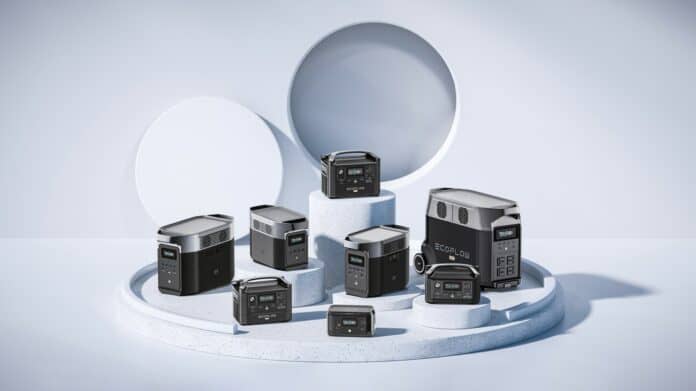Imagine your life without electricity. With power outages on the rise, you need to find a home backup power solution — independent of the aging electricity grid.
Luckily, home battery backup has become more affordable and advanced than ever. Portable power stations (PPS) provide the answer when you’re looking to provide energy security for your home.
From charging personal devices like laptops and smartphones during a camping or off-grid trip to running your entire home during a blackout, there’s a PPS option for you.
The best portable power station for you depends on your use case and electricity consumption needs.
Before making a purchase decision, make sure that the portable power station delivers what you need.
Among these many portable power stations on the market, we’ve narrowed it down to six of the best in 2024.
Find your solution here and be prepared for any situation — from off-grid excursions to blackouts.
6 Best Portable Power Stations in 2024
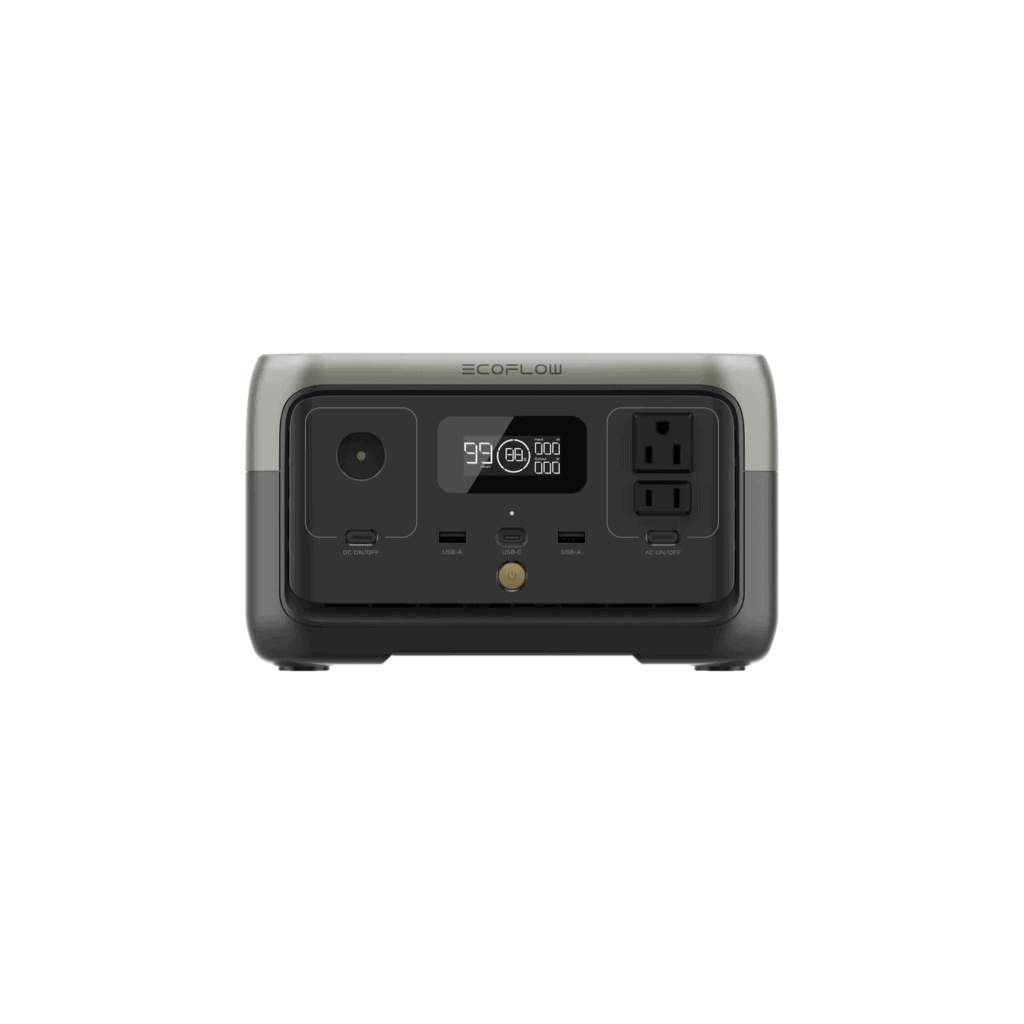
EcoFlow RIVER 2 Portable Power Station
At just 7.7 pounds (3.49 kg), the EcoFlow RIVER 2 portable power station is small enough to carry in a backpack. It’s perfect for charging your personal devices on a camping trip or off-grid getaway.
Charge the RIVER 2 up, pack it away, and plug in your personal electronic devices whenever you need.
The RIVER 2’s plug-and-play setup is effortless. With two AC plugs for your personal devices and small appliances, as well as USB-A and USB-C outlets, you can charge or run your essentials anytime.
With an industry-leading AC power charge time of just 60 minutes, you can charge the RIVER 2 while you pack your backpack — it will never slow you down.
The RIVER 2 is the smallest of EcoFlow’s portable power stations but still delivers 256Wh storage capacity, with an operating power output of 300W. With X-Boost, you can achieve surge power (starting watts) of 600W to run almost any small appliance and charge any personal device.
Recharging the RIVER 2 is easy. You can charge using your vehicle’s DC output or AC electricity from a standard wall plug at home before you go.
Like all EcoFlow portable power stations, RIVER 2 also offers solar charging with compatible solar panels. You can recharge off-grid with solar energy in approximately three hours.
Pros
- Lightweight and easily portable
- Fast charging time
- Simple plug-and-play startup
- An inexpensive source of portable power
Cons
- Less storage and output capacity than other portable power stations
EcoFlow RIVER 2 Max Portable Power Station
The EcoFlow RIVER 2 Max is bigger and more powerful than the RIVER 2 while remaining very lightweight and compact. It comes in at 13.2 pounds (5.98 kg), with a handle to make carrying easier.
It’s an ideal device for an off-grid trip because you can carry it anywhere, set it up on a table or desk, and plug in what you need. No need to give up your tech or luxuries on a remote cabin or RV trip — with portable power for your smartphone, laptop, or television, you’re ready to go.
The RIVER 2 Max has an electricity storage capacity of 512Wh. It’s enough to operate 80% of essential appliances so that you can run just about anything. With four AC outlets as well as USB-A and USB-C ports, the RIVER 2 Max delivers 500W of operating electricity and surge power of up to 1000W using proprietary X-Boost technology.
Like the RIVER 2, the RIVER 2 Max reaches a full charge in about an hour using AC electricity or approximately three hours if you use solar panels. It also boasts an exceptional lifespan, thanks to a LiFePO4 battery that can last a decade or more without diminishing efficiency.
Backed with a five-year warranty, the RIVER 2 Max is built to last.
Pros
- Tremendous portability for the amount of available power
- Higher storage capacity and power output than the RIVER 2
- Fastest charge times in the industry — 5x quicker than other portable power stations
- Four AC power outlets, as well as USB-A and USB-C ports for powering multiple devices at once
Cons
- 500W output capacity (1000W surge power with X-Boost) can power only 80% of essential appliances
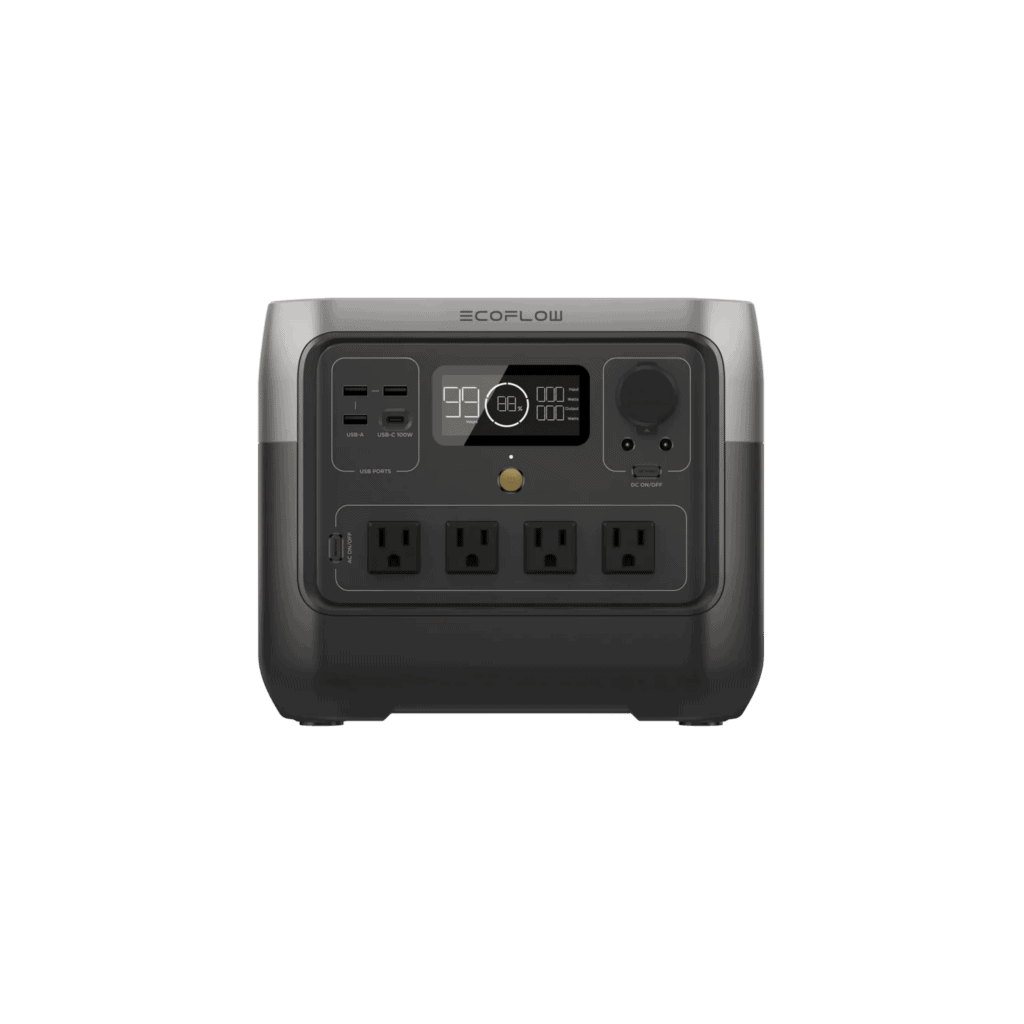
RIVER 2 Pro
The EcoFlow RIVER 2 Pro is the most powerful member of the RIVER 2 family. Even so, it weighs only 17.2 pounds (7.80 kg), so it remains highly portable. It’s perfect for road trips and won’t take up too much space in your vehicle.
The RIVER 2 Pro is also ideal for powering essential devices and small appliances in a van or RV. You can run 80% of high-wattage appliances, such as an RV refrigerator, along with charging all your personal electronic devices.
It’s small and lightweight enough to carry in one hand if you want power at a campfire or to relax and power your electronics outside the confines of the vehicle.
The 768Wh storage capacity can provide enough electricity to keep your personal devices charged for days. With four AC outlets, USB-A and USB-C — and 800W of power output (1600W surge power with X-Boost) — you can power multiple devices simultaneously.
Like the other RIVER 2 series power stations, the RIVER 2 Pro charges quickly. It takes 70 minutes to fully charge from an AC power outlet plug or in as little as three hours if you purchase a 220W bifacial solar panel. You can also recharge using a car adaptor or USB-C.
Because it can power 80% of high-wattage home appliances, the RIVER 2 Pro isn’t just for camping or off-grid adventures. With a 30ms switchover speed during a power outage, you can ensure virtually uninterruptible power for essential appliances in your home — anything from a laptop to a fish tank.
Pros
- Plug and Play operation
- Solar charging (with optional solar panels)
- Sufficient power output to run 80% of high-wattage home appliances
- Lightweight for the level of power output and storage available
- 4 charging options with industry-best recharge times
Cons
- Despite its lightweight build, the RIVER 2 Pro May be too bulky to carry in a backpack
[wptb id=3032]
DELTA 2
The EcoFlow DELTA 2 Portable Power Station is a medium-capacity home backup and off-grid power solution. It delivers 1024Wh of storage capacity out of the box, and you can expand double that to 2048Wh by adding a Smart Extra Battery.
With six outlets and 1800W of electricity output, you can use it to power 90% of appliances. X-Boost gives you up to 2700W of surge power to get major appliances up and running.
The DELTA 2 remains a highly portable option, weighing only 27 pounds (12 kg), so you can easily take it with you on a road trip to meet your energy needs off-grid.
It also serves as a robust home backup power source. During a blackout, you can plug your essentials directly into the DELTA 2 and reduce the impact of a power outage.
Like all EcoFlow DELTA portable power stations, you can monitor and manage your DELTA 2’s usage with the EcoFlow smartphone app from anywhere with internet access giving you freedom and flexibility.
Between uses, you can charge up to 80% in only 50 minutes using AC power or three to six hours with optional solar panels. The DELTA 2 supports up to 500W of solar charging input.
Pros
- Affordable home backup power source
- Lightweight and portable for versatile use
- Expandable capacity to adapt to your needs
- Fast recharge to help ensure electricity is always available in a power outage
Cons
- Solar panels not included
- Not enough power output or storage capacity to run an entire house during a blackout
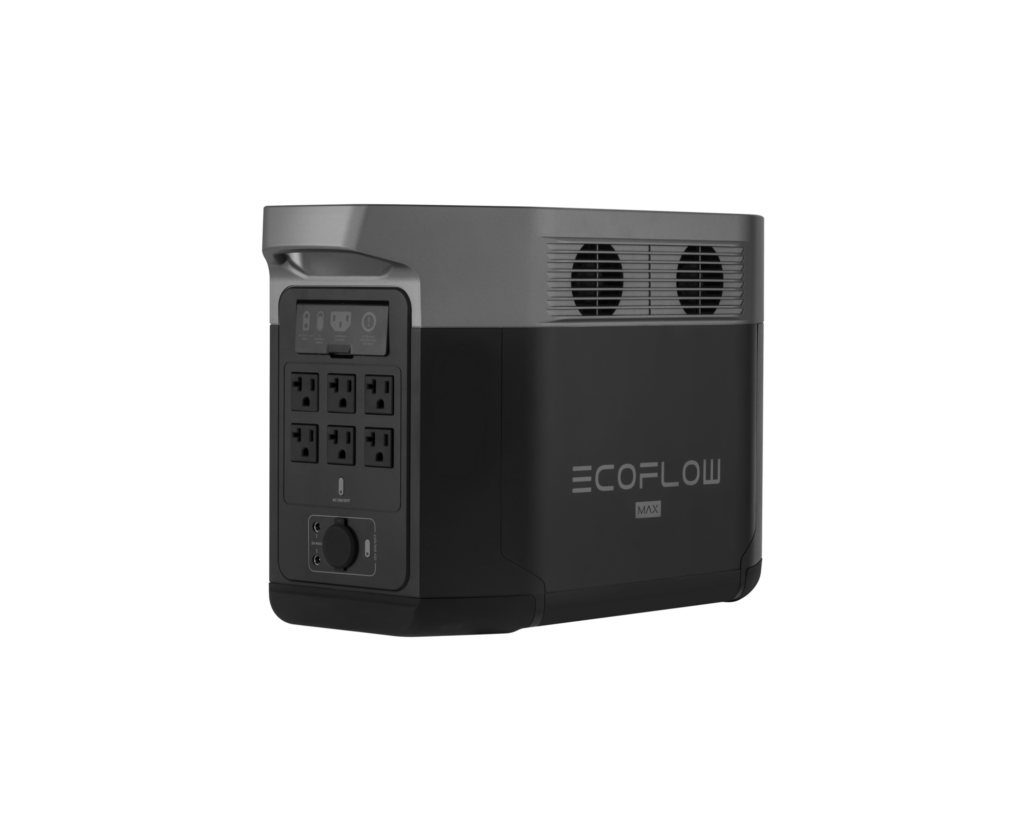
DELTA Max
The EcoFlow DELTA Max gives you another step up in power, with a storage capacity of 2 kWh that expands to 6kWh. Out of the box, six AC outlets provide 2400W of output or 5000W with an X-Boost. That’s ample electricity to start and run just about any appliance and provide crucial backup for several days.
At 48 pounds (22 kg), the DELTA Max is less portable than the EcoFlow RIVER 2 series and DELTA 2 power stations, but it’s a robust backup power option for your home.
The plug-and-play functionality can have you back up and running almost immediately during a blackout. You can recharge to 80% capacity in 65 minutes with an AC outlet between outages or in just 2.5 hours with solar panels. The DELTA Max can provide real peace of mind and energy security when the grid fails.
The DELTA Max also integrates seamlessly with EcoFlow’s Smart Generator Dual Fuel. Once the DELTA Max battery depletes, it switches to the Smart Generator to automatically recharge. The Smart Generator Dual Fuel runs on petrol and propane (LPG), providing additional energy security during an extended outage.
Pros
- Power output capacity to start and operate almost any appliance
- Depending on your usage, you can back up essential appliances for several days
- Fast recharging using 4 different methods, including solar
- 15 total outlets, including 6 AC outlets, USB-A, USB-C and DC to run multiple appliances at once
- Expandable battery storage capacity
Cons
- Smart Generator Dual Fuel not included
- Only portable power featured to use older nickel-cadmium (NCM/Ni-Cad) battery chemistry
DELTA Pro
The EcoFlow DELTA Pro is the largest, most powerful portable power station in the EcoFlow line. It begins at 3600Wh of electricity storage capacity, expandable to as much as 25kWh. One DELTA Pro delivers 3600W of power output and 7200W of surge power with X-Boost. You can chain 2 DELTA Pros together using a Double Voltage Hub and double your power output capacity to 7200W/240V.
The DELTA Pro is the first portable power station designed to provide backup energy for your entire home. It’s at the heart of EcoFlow’s Smart Home Ecosystem and whole home power backup solutions — which can run the average home for up to a week without recharging.
In a blackout, the DELTA Pro can charge everything. The high power output and expandable storage capacity give you energy security even during extended outages.
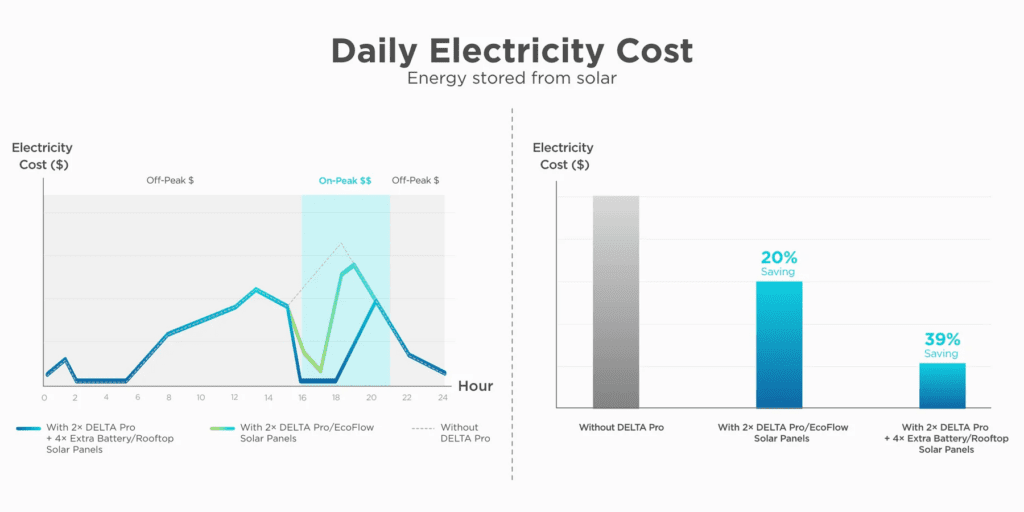
You can also switch to using the DELTA Pro instead of grid power at peak energy times to save on your electric bill with clean energy. You can save significantly on your electricity bill over time when you charge with solar panels. The DELTA Pro supports 1600W solar charging input to connect four of EcoFlow’s rigid or portable 400W solar panels.
The DELTA Pro charges completely in as little as 1.8 hours using an AC wall outlet or between 2.8 and 5.6 hours (depending on environmental factors) using 4 x 400W solar panels (1600W).
You can even recharge the DELTA Pro at electric vehicle (EV) power stations across the country, adding an extra charging option for added convenience.
The DELTA Pro integrates with your existing home electrical wiring by connecting to the circuit panel with a transfer switch or the EcoFlow Smart Home Panel. Like the DELTA Max, the DELTA Pro integrates effortlessly with the Smart Generator Dual Fuel to provide a petrol and propane-powered last line of defence for your energy security.
Thanks to its high capacity and expandability, the DELTA Pro is the most potent, versatile portable power station on the market today. You might even be eligible for tax credits and incentives — including a 30% federal solar tax credit to help defray your upfront costs. Financing options are also typically available.
Pros
- It can provide enough power for your entire home
- Multiple charging options, including AC, solar, car adaptor, and EV
- Durable, heavy-duty design
- Easy integration with your home wiring for uninterrupted power during an outage
- Can provide electricity for central home heating and air conditioning system
- Expandable to achieve complete energy independence using solar power as a clean, renewable off-grid power source
- Control and monitor usage from anywhere with the EcoFlow smartphone app
Cons
- At 99 pounds, it’s less portable than other power stations
[wptb id=3033]
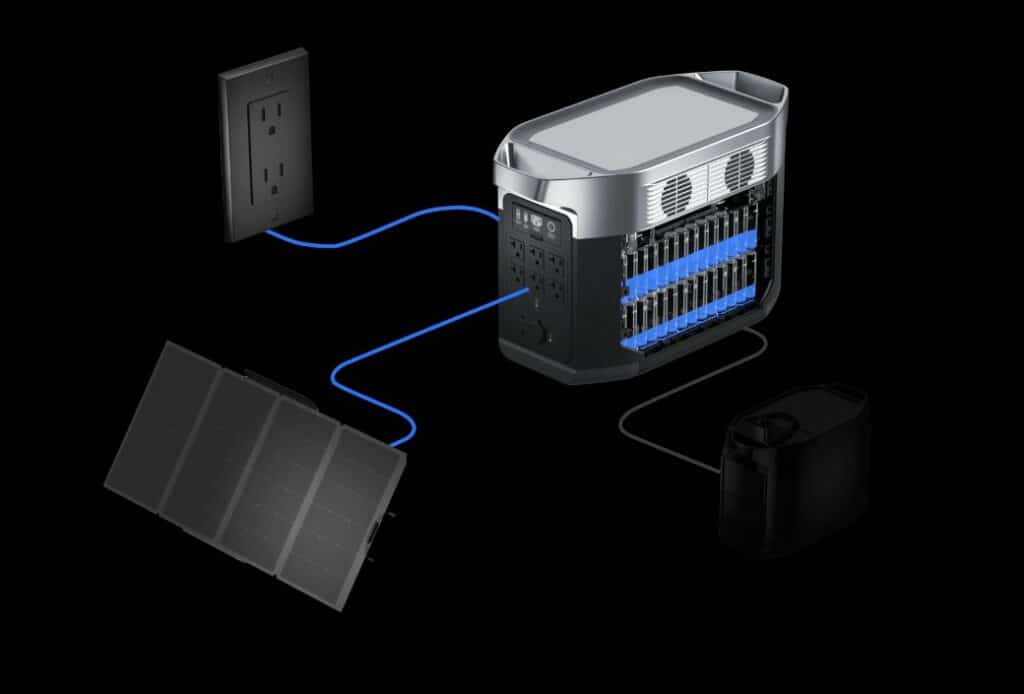
What to Consider When Buying a Portable Power Station
When you look at these models, you won’t see a definitive “best” option for all circumstances. You aren’t shopping for a portable power station for a hypothetical average person or household; you are shopping for yourself and your unique needs.
Breaking down your requirements will help you choose which portable power station is right for you.
Your Purpose
What do you hope to accomplish with your portable power station? You might focus on convenience and portability if you want to get away from it all and charge small, essential devices during a mostly unplugged escape from the world.
In this case, you don’t need the kind of power to backup your entire home’s electric supply. A high-capacity option could be overkill for off-grid adventures — whereas the RIVER 2 Series should be just right.
If you’re looking primarily for a home electricity backup source, carefully consider how many appliances and systems you want to run simultaneously during a power outage.
The incidence of blackouts can vary widely across the United States, so it’s worth keeping your location in mind when deciding how much power output and storage capacity you need.
Clearly define what you need from your portable power station before making a purchase decision.
Appliance and Device Electricity Consumption
As mentioned above, consider what devices and appliances you want to use. The starting and running wattage needs of your appliances can help you determine what portable power options are available to you.
Don’t wait for a blackout to find out your portable power station can’t start up your fridge.
Add up the running and starting wattages of your essential appliances, then confirm your portable power station can meet or exceed your needs.
Taking a power consumption inventory of the electronics you need to operate will prevent you from wasting time and money on a portable power station that won’t meet your requirements.
Portability
Not all portable power stations are equally portable. Some are compact, designed to pack in a small space, carry with you to a campsite, and stay on the move. But with the DELTA Pro coming in at 99 pounds, you may want to roll it behind you on a campground trail.
If you’re looking solely for home backup, your power output and consumption requirements will outweigh your portability needs.
If you need something to take with you wherever you go, the smaller, lighter portable power stations like the RIVER 2 series and DELTA 2 will likely make more sense.
For permanent off-grid solutions for RVs and tiny houses, EcoFlow’s modular Power Kits are also worth a look.
Electrical Power Output
As a general rule, with portable power stations, the larger and heavier the unit, the more electricity it can store and output — balance portability concerns against capacity. The smaller power stations won’t cut it if you need to power a high-energy appliance like an air conditioner or a large fridge.
On the other hand, if you just want to charge your smartphones and laptops, the DELTA Pro will seriously exceed your requirements.
Starting and Running Watts of Typical Household Appliances
| Appliance | Rated (Running) Watts | Starting Watts |
| Dishwasher | 1300 | 1800 |
| Washing Machine | 1200 | 2300 |
| Refrigerator/Freezer | 700 | 2200 |
| Light Bulb | 60-75 | 0 |
| Microwave | 600-1000 | 0 |
| TV | 500 | 0 |
| Toaster | 900 | 0 |
| Vacuum | 1440 | 2500 |
| Coffee Maker | 1000 | 0 |
| Blender | 300 | 800 |
| Clothing Iron | 1500 | 0 |
| Dryer | 5400 | 7000 |
| Toaster Oven | 1200 | 0 |
| Curling Iron | 1500 | 0 |
| Space Heater | 2000 | 0 |
| Laptop | 50-300 | 0 |
| 20” Box Fan | 200 | 350 |
Of course, you may be looking for a variety of uses. Planning for mostly-unplugged camping and home electric security might require buying a versatile portable power station like the RIVER 2 Pro or DELTA 2 — or buying more than just one model.
Either way, you want to ensure that you have enough electrical output for your anticipated off-grid activities and home backup needs.
Battery Storage Capacity
The starting power of your largest appliance isn’t the only factor in how much power you need. As mentioned above, you need to calculate the total operating electrical consumption of the sum total of appliances you want to run simultaneously. And estimate how long you want to be able to run your devices without recharging the portable power station.
Battery capacity, measured in kilowatt-hours, is the number of watts the power station can deliver multiplied by the number of hours. For example, running a device that requires 200 Wh of electricity consumption for ten hours requires 2 kWh — the same capacity as operating a device that requires 2000 watts for one hour of use.
When in doubt, aim for a storage capacity 20% higher than your expected needs. If you’re only charging a few devices for a short time — such as recharging smartphones on a camping trip — you can get away with much less planning than when you’re preparing a home backup power system for a blackout.
Charging Time and Convenience
The longer it takes to charge a portable power station, the less convenient it becomes. By purchasing a portable power station, you’re already thinking ahead, but the quicker you can recharge between trips or power outages, the more secure your energy supply will be.
The quickest recharge times typically come from plugging into an AC wall outlet. During a blackout, that’s obviously not an option. A portable power station that you can charge with solar panels, using a car adaptor, USB-C or, in some cases, an EV charging station gives you more versatility and more options to respond to whatever power emergency gets thrown at you.
Price and Your Budget
Buying a portable power station can represent a significant investment. But buying the cheapest option that ends up not meeting your needs is more wasteful than purchasing a more expensive option that meets your electricity storage and generation needs.
With so many EcoFlow solutions to choose from, look for an option that fits your budget and fully meets your needs.
You may also find that financing, discounts, or tax credits and incentives can help defray your initial costs. Take the time to accurately assess your use case and PPS options to ensure you make the best investment for your home backup or off-grid power needs.
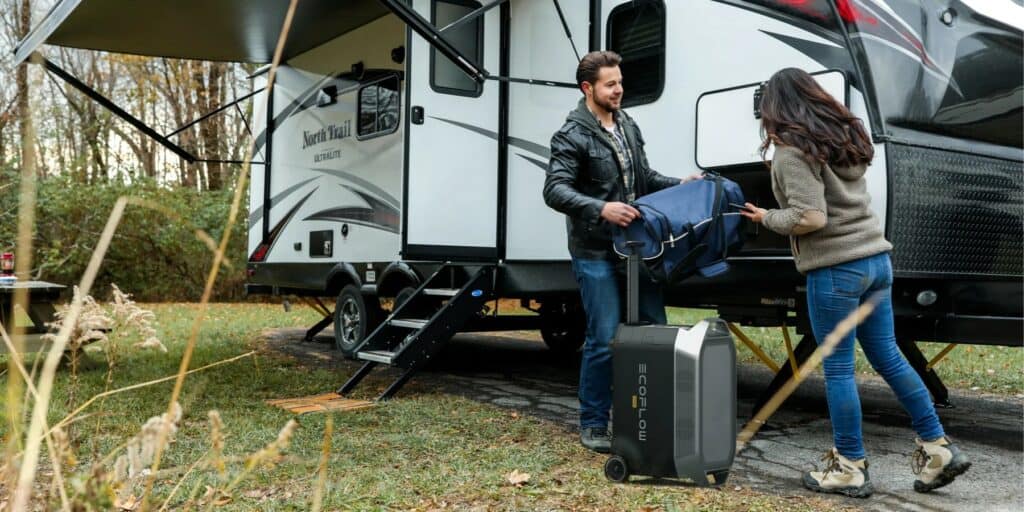
FAQs
How long a portable power station will operate without recharging depends on how much energy you consume and your battery storage capacity. When it comes to life span, EcoFlow portable power stations can last for thousands of cycles (discharging and recharging the battery). Heavier use will mean a shorter overall chronological life span before battery efficiency starts to diminish. A portable power station that uses LiFePO4 battery chemistry can last ten years or more, with options like the DELTA Pro rated for 6500 cycles before reaching 50% capacity.
The devices or appliances you can run depend on their starting and operating wattage and run times. If your portable power station doesn’t provide enough output wattage to start or run your desired appliances, you’ll need to purchase a larger PPS. The most robust portable power stations can expand to provide enough power to run your entire home. Check the starting and running wattage of the appliances you want to operate and purchase a PPS with sufficient electricity output.
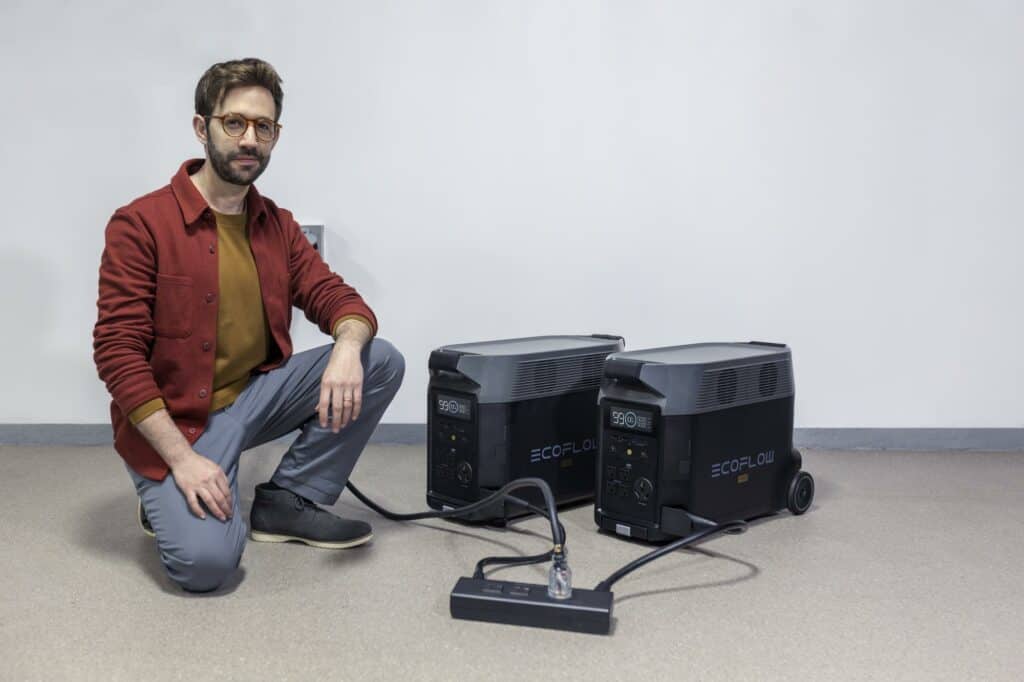
Conclusion
No portable power station is right for everyone — but one of the six options reviewed above is almost certainly right for you. Once you understand your power needs, you can find a portable power station to deliver.
From the compact RIVER 2 series to the immense power of the DELTA series, the EcoFlow line of portable power stations includes options you can take anywhere and options that can get your home and family through an extended blackout.
Take the time to learn more about our products so you can find the right portable power station for you.


